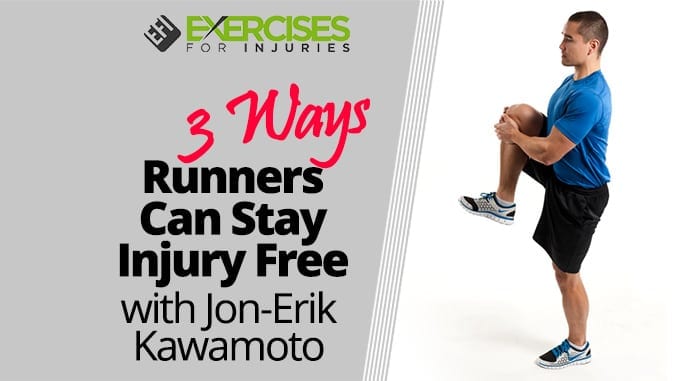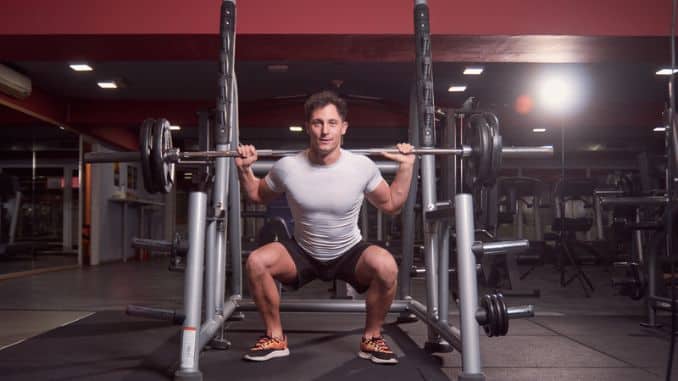
3 Ways Runners Can Stay Injury Free
By Jon-Erik Kawamoto, MSc Kin(c), CSCS, CEP
Staying injury free for long-term running success is no easy feat. Many factors come into play when you’re training for that upcoming race or hitting the trails.
It’s challenging to get runners in the gym. Most fear that if they lift a weight, they will instantly turn into the Hulk, which couldn’t be further from the truth. However, numerous studies show improved running performance and reduced injury risk when runners include strength and plyometric exercises in their endurance program. Let me see if I can change your mind.
The Science
The review paper titled Effects of Strength Training on Endurance Capacity in Top-Level Endurance Athletes discusses concurrent strength and endurance training in highly trained endurance athletes (Aagaard & Andersen, 2010).
Previous research in this area is equivocal. Some studies show improvement in endurance performance, while others have found an attenuated cardiovascular response.
Aagaard and Andersen (2010) found that the benefits of endurance training and the benefits of strength exercises for runners were seen without any adverse effects on endurance running performance in moderately-trained to elite top-level athletes. The muscle size did not change, and capillary density was not affected.
What worked was a heavy resistance strength training protocol.
This is what they found:
- Improved neuromuscular communication (rate of force development and maximal voluntary contraction)
- Increased tendon stiffness,
- Increased the percentage of Type II A muscle fibers
“…strength training can lead to enhanced long-term (>30 min) and short-term (<15 min) endurance capacity both in well-trained individuals and highly trained top-level endurance athletes, especially with the use of high-volume, heavy-resistance strength training protocols.” –Aagaard & Andersen (2010)
Other studies have found that adding plyometric training to a running program improved the running economy with no adverse effects on the cardiovascular system (Paavolainen et al., 1999; Saunders et al., 2006; Turner et al., 2003).
Lastly, a study with female cross-country runners found that supplementing the running program with strength training (not plyometrics) also led to improvements in running economy (Johnston, Quinn, Kertzer, & Vroman, 1997).
I know you’re tying up your runners and heading to the gym, but before you go, apply these three tips to ensure you stay injury-free in the gym and on the track.
1. Learn the difference between the squat and hip hinge pattern
The barbell back squat is traditionally seen as a “basic” lift; however, most runners perform this lift incorrectly.
Top 3 Problems Runners Have:
- Insufficient depth
- Rounded back
- Valgus (inward) knee
Technique Fix Tip To Stay Injury Free: THE GOBLET SQUAT
- Hold a dumbbell in front of your chest lengthwise with your elbows pointing downward.
- Sit in between your feet while keeping your chest up/out
- Squat ass-to-grass with your hip-crease below your knee-crease
- Finish with your elbows on the inside of your thighs
- Allow your torso to lean forward slightly to maintain balance over your mid-foot
- Do not allow your back to round forward – stay tight and firm in your core throughout the exercise
Over several weeks, progress to the heaviest dumbbell you can find. Not only is this challenging for the legs, but the core and spinal erectors get a great workout too. I recommend all runners be able to perform perfect heavy Goblet Squats before attempting barbell front or high-bar back squats.
You can trust the motor pattern, mobility, and stability with deep Goblet Squats will help you achieve your goals of increasing strength in your legs and hips while also increasing core stability.
On to the hip hinge
This movement pattern is essential for performing perfect Deadlifts, Olympic lifts, and Russian Kettlebell Swings. For optimal utilization of the posterior chain (glutes, hamstrings, back extensors), the hip hinge with zero back flexion/extension is imperative to improve the athletic potential and run performance. Tapping into the posterior chain will also help reduce the injury risk associated with distance running.
Stay Injury-Free Technique: STANDING HIP HINGE DRILL
- Stand with your feet 8-10” apart.
- Place one hand on your low back and one on your stomach
- Slightly bend your knees
- Push your hips back, back, back while you bow forward – you should feel the tension in your hamstrings as you reach 90 degrees at your hips.
- Use your hands to feel if your back starts to round
- Stay long and tight in your core, and keep your chest out
Learn and own this movement. Apply it to your training – the Romanian Deadlift is a great exercise for runners. Hold a loaded barbell with a double overhand grip in front of your thighs. Stand with your feet hip-width apart. Keep the bar close to your legs and perform the hip hinge described above. Once the bar passes your knees, return to the standing position. To build strength, complete sets of 5 or less with at least 2-minutes rest between sets.
Moving through the hips will develop strong-ass glutes and hamstrings while sparing the spine and knees.
2. Correct for Muscle Imbalances
Due to the nature of the running stride (especially at slow paces), the body and joints repeatedly move through a particular range of motion. This highly repetitive nature results in common muscle imbalances forming in runners compared to non-runners.
If you are looking for a great resource on muscle imbalances, check out Muscle Imbalances Revealed.
Shirley Sharmann (2002), in Diagnosis and Treatment of Movement Impairment Syndromes, writes that runners typically have overdeveloped hamstrings and usually weak hips. Weak hips can lead to many injuries in the hip joint and the knees. Runners with weak gluteus maximus muscles are prone to hamstring strains, whereas runners with weak hip abductors and hip stabilizers are prone to lateral knee pain.
Before going on runs, activate the glutes in your warm-up.
My favorite drill is the Super Dog, an exercise I got from fitness expert Nick Tumminello. Kneel on a mat and bring one knee to your chest. Extend your other leg and rest your upper body on your elbows. Bringing your knee to your chest flexes the hip and prevents lumbar extension during this exercise. Lift the straight leg upward while trying to extend your hip. Perform 12 to 15-reps per side and perform two sets.
Another great warm-up drill for runners involves activating the deep hip flexors. Lie on your back with a mini-band wrapped around your feet. Bring your knees to your chest. Keep one knee tight with your stomach while pressing the opposite leg away. Hold the end position for 5-seconds. Perform 8- to 10-reps per side.
3. Be wise when choosing your exercises to stay injury free
Not all exercises are created equal. The Iron Cross is a standard warm-up exercise at track and field meets that attempts to warm up the hip flexors while dynamically stretching the hamstrings. Here, the runner faces up with their arms out to the sides. One foot is brought to the opposite hand with a straight leg. This warm-up exercise forces lumbar rotation and flexion upon a fixed torso, a recipe for disc disaster. Dynamic loads directed to the spine in this nature are unsafe and may result in injury.
Instead, perform the Knee-Hug Crossover Lunge.
This drill works on the hip range of motion while activating the legs and hips in the standing position. This exercise will have more functional carryover to running and be more effective at warming you up than the Iron Cross. Plus, the dynamic rotational load is removed, thus, sparing the spine.
Stand tall and hug one knee.
Feel a stretch under your thigh and into your glute. Release the hug and with control, step the same leg backward, diagonally behind your stance leg. Some refer to this as a “curtsey” lunge. Keep your shoulders and hips square – you should feel a good stretch in your hip. Stay tall and drive your front foot down to stand back up. Repeat on the other side and perform 10 per side, twice, before your run.
Jon-Erik Kawamoto, MSc Kin(c), CSCS, CEP, is a Personal Trainer and Freelance Fitness Writer based in St. John’s, NL, Canada. Jon ran track and field for nine years with 15:13 and 32:15 personal bests in 5-km and 10-km races, respectively. He regularly contributes to many significant health and fitness magazines such as Canadian Running, Men’s Fitness, and Oxygen. You can reach Jon and read more of his work at www.StrongerRunner.com.
Huge thanks, Jon.
Rick Kaselj, MS



